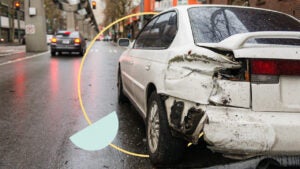California rate filing freeze starts to thaw

California might be one of the largest markets for auto insurance in the nation, but a two-year freeze on auto insurance rate filings has been spelling trouble for insurance companies and drivers in the state. The freeze, along with a return to pre-pandemic levels of driving that increased accident severity and resulted in more expensive claims, has forced car insurance companies in California into a difficult financial position. But that could be about to change. Bankrate spoke with Vice President Denni Ritter of the American Property Casualty Association (APCIA) to learn more about the state of the auto insurance industry in California and how it affects drivers in the state.
- Until October 2022, California’s Department of Insurance had not approved any auto insurance rate filings since May 2020, despite over 75 percent of companies that sell car insurance in the state filing for a rate increase, according to APCIA.
- Allstate was the first carrier since May 2020 to receive approval for a rate increase of 6.9 percent, which would affect 992,000 policyholders starting December 28, 2022.
- Multiple insurance companies reported loss ratios of over 100 percent in California in 2022, indicating that their claim costs were higher than their incoming premium, according to APCIA.
- Changes implemented by car insurance companies in California because of their operating and claim losses could make it difficult for drivers to shop for car insurance.
When did California’s troubles begin?
In March 2020, California was the first state to roll out stay-at-home orders in response to the COVID-19 outbreak. It was a decision that shifted driving habits in the state overnight — early studies from UC Davis found an estimated 60 percent drop in traffic volume in April 2020, which resulted in a nearly 50 percent decrease in roadway collisions.
Because of this reduction in driving habits, the California Department of Insurance directed car insurance companies to issue premium refunds to drivers. In total, car insurance companies returned around $2.4 billion in premium refunds to California drivers.
Pandemic response: California halts rate filings
At the beginning of the pandemic, many insurers also withheld or withdrew rate filings that had been submitted to the state’s Department of Insurance for approval. However, as the pandemic evolved and states re-opened, drivers got back on the road. Statistics from the Federal Highway Administration found that the amount of miles driven in 2021 and 2022 were now close to or exceeding miles driven in 2019 and 2020.
Up until recently, the Department has maintained its stance. In a statement provided to S&P Global in November 2021, the Department of Insurance indicated that the pandemic was still ongoing and that driving habits were still decreased.
“People returned to pre-pandemic driving levels,” says Ritter, “and some folks developed bad driving habits, like speeding, not wearing seat belts and driving while intoxicated.” Poor driving habits nationwide are commonly cited as a reason for rising car insurance rates, and it’s certainly true in the Golden State as well. In California specifically, a study from the National Highway and Traffic Safety Association saw a 10.7 percent increase in traffic fatalities in 2021 compared to 2020. The agency reported that 4,258 people died in vehicle crashes in the state in 2021, compared to 3,847 people in 2020.
The APCIA also found that while auto claims with physical damage losses dropped 30 percent in 2020, they increased by 60 percent in 2021. Increased accidents mean more claims, which are also more expensive now due to the pandemic’s effect on supply chain issues and historic inflation. And a longer repair time also means more expensive rental car costs while the vehicle sits in the shop — Hopper found that in May 2021, car rental rates were up 95 percent compared to the beginning of the year. Daily rates in Los Angeles were around $94 per day.
What have car insurance companies in California been doing?
Car insurance companies in California have been open about the challenges of operating in the state. In recent earnings calls, several major insurers like Allstate, Geico, Kemper and Liberty Mutual reported loss ratios of over 100 percent in California. This means that they paid out more in claims than they received in premiums, and without rate adjustments, it’s difficult for car insurance companies to resolve the imbalance.
Normally, car insurance companies can balance their risk exposure, continue to pay out claims and avoid insolvency by being more strict about what new business they take on or filing for rate increases. But these options aren’t possible in California.
That’s because of a measure passed in 1988. “Proposition 103 turned California into a ‘take-all-comers’ state,” explained Ritter. “This means that if you’re a good driver in the state and you apply for insurance, an insurer has to offer you coverage.” This is even if an insurance company is experiencing losses and continuing to pay out more in claims.
Tricia Griffith, CEO of Progressive, said in the firm’s third-quarter earnings call in November 2021,
The moratorium on rate increases in California is unfortunate because we don’t think it serves the consumers of California, and you only have a couple of things to do.
— Tricia Griffith CEO of Progressive
She went on to note, “There’s a couple of levers that we talked about, and we’ll use those tactics to slow growth, but we want to be a part of the future California market, and we’ll do what we can to get there.”
For Progressive, this has meant limiting advertising in the state. Other carriers, like Allstate, tried to limit payment plans or prohibited independent agents from selling its personal lines products. Geico has even closed all physical storefronts in California and no longer allows customers to call in for a quote. Instead, prospective clients must start a car insurance quote online.
Recent developments: Are rate increases in California coming?
Under Prop 103, car insurance companies in California must also receive approval from state regulators before a new rate change can be carried out. And for nearly two years, California’s Department of Insurance had not approved any rate changes, leaving insurance companies to make difficult decisions when it came to doing business in the state.
However, it was announced in late October 2022 that Allstate was the first insurance company approved for a rate change in California since the freeze. Although the company initially requested a 15.8 percent increase, Allstate was approved for a 6.9 percent increase, which is the maximum allowed increase under state law without prompting a public hearing. Many of the largest car insurance companies in the state, including State Farm, Geico and Progressive, are still waiting on the status of their rate filings. Altogether, the upcoming decisions on rate filings could result in hundreds of millions of dollars of new insurance premiums.
What does this mean for California drivers?
As more rate filing decisions are announced, it’s likely that California drivers will see a more expensive premium on their renewal statements in 2023 and beyond. Taking steps to review your car insurance policy and potentially even shop around for car insurance quotes could be one way to help keep your car insurance premiums within your budget. Still, it may not have been as easy as it once was to shop for car insurance in the state.
While it may have seemed like a boon for California drivers not to have to face rate increases for the past few years, there are negative consequences that could continue to persist. The ongoing situation may have made it harder for California drivers shop, quote and buy car insurance policies online. And the best car insurance companies in California may be limited on where they can offer coverage to drivers, but drivers might not be aware until they take the extra step to call an insurance agent or company hotline.
This could be especially true for those that don’t have access to the internet to shop for policies online and have more complicated needs that require a local insurance agent. Additionally, as one of the most diverse states in the nation, nearly 44 percent of Californians speak a language in addition to English, with 17.4 percent lacking a strong proficiency in English. These drivers could have the most difficult time navigating a phone or online-only process when shopping for car insurance or dealing with car insurance claims, especially if translation services aren’t provided or easily accessible.
According to Joseph Lacher, CEO of Kemper Insurance Company, in the company’s auto insurance report,
What we’re increasingly seeing is carriers, ourselves included, that are becoming increasingly less willing to write new business, more restrictive from an underwriting perspective, tightening everything they can.
— Joseph Lacher CEO of Kemper Insurance Company
The bottom line
What’s happening in California is unlike anywhere else in the country. Before the announcement of Allstate’s rate filing, Ritter noted how “the unprecedented losses in the auto insurance market, coupled with no regulatory rate relief on the horizon have caused insurers in California to take the unusual step of trying to limit their exposure to new business. This highly competitive industry is no longer competing for new business in the largest market in the country.”
Now, change may be coming. Nearly two years after California first implemented shelter-in-place measures to prevent the spread of COVID-19, the landscape of the state has altered for car insurance companies. And while California drivers have recently been able to avoid rate increases, that may no longer be the case.
Why we ask for feedback Your feedback helps us improve our content and services. It takes less than a minute to complete.
Your responses are anonymous and will only be used for improving our website.
You may also like

What is the ROI of your college degree?

Car insurance for a hit-and-run: What you need to know




